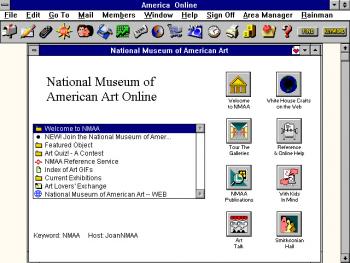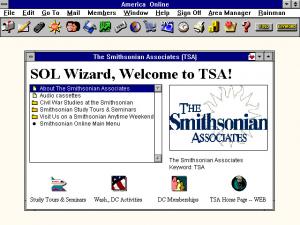 In the 1990s, it seemed like America Online (AOL) was everywhere. Diskettes and CDs that offered the dial-up online service arrived in mailboxes and on college campuses frequently across the United States. Even the Internet Archive has a collection of them now.
In the 1990s, it seemed like America Online (AOL) was everywhere. Diskettes and CDs that offered the dial-up online service arrived in mailboxes and on college campuses frequently across the United States. Even the Internet Archive has a collection of them now.
AOL teamed up with the Smithsonian in 1993 to offer audiences Smithsonian Online (SOL). This resource had visitor information, teacher publications, National Museum of American Art (now the Smithsonian American Art Museum) Online, photos, and message boards. Other online service providers CompuServe and Genie also had Smithsonian photos available for downloading.
Minutes from a Smithsonian meeting indicated Smithsonian Online was a successful launch, as the service had more subscribers than expected by AOL when it became available. For July 1993 there were almost 3,000 subscriber hours. By January 1995, there were nearly 11,200 hours logged on SOL. AOL subscribers paid by the hour. In comparison, the Smithsonian had 134 million website visitors for fiscal year 2016.
The National Museum of American Art became the Smithsonian’s “first virtual museum” through AOL. Users could submit questions online and many sought information about artists. Other features included online tours and contests. Other offerings that were planned in 1994 for Smithsonian Online included more images, message boards, and teacher materials from the National Museum of American History, the Smithsonian Magazine Online, and information about membership and events through The Smithsonian Associates. By 1996 there were real-time chats, holiday features, and a 150th anniversary celebration of the Smithsonian. Chat topics with experts included Hispanic Art in the U.S., History of Computers and Technology, and The Physics of Star Trek. Subscriber comments were favorable about the service.

 Promotional material touted that computer networks were bringing the Smithsonian to the world. “A computer, a modem, and a telephone line are all you need to travel to the Smithsonian, any day, any time. Use the Internet or a commercial network to explore a wide range of educational materials,” a flyer stated.
Promotional material touted that computer networks were bringing the Smithsonian to the world. “A computer, a modem, and a telephone line are all you need to travel to the Smithsonian, any day, any time. Use the Internet or a commercial network to explore a wide range of educational materials,” a flyer stated.
The Smithsonian Office of Elementary and Secondary Education (now the Smithsonian Center for Learning and Digital Access) launched the Smithsonian Online Kids’ Castle in August 1996. The content was accessed through AOL with the keyword “SI Kids.” Created for ages 6 to 12, more than 6,000 children across the globe had joined as SI Kids members, according to the Smithsonian staff newsletter, The Torch, from February 1997.
During the 1990s, the Smithsonian worked on other Internet and web projects since this area was gaining recognition as an important tool to reach the public. The Smithsonian homepage launched May 8, 1995, paving the way for more Smithsonian websites. NMAA’s partnership with AOL ended in 1998 when the museum was able to host its own site and develop online exhibitions.
Today there are more than 1,000 websites, subsites, blogs, and social media accounts representing nearly every facet of the Smithsonian, which has expanded greatly from the early foundations of this AOL partnership.

Related Resources
Accession 98-094, Smithsonian Website Reords, 1995, Smithsonian Institution Archives
From a Humble Beginning: The Smithsonian's first Internet Domain, The Bigger Picture, Smithsonian Institution Archives
The Electronic Smithsonian, The Bigger Picture, Smithsonian Institution Archives
Produced by the Smithsonian Institution Archives. For copyright questions, please see the Terms of Use.

Leave a Comment